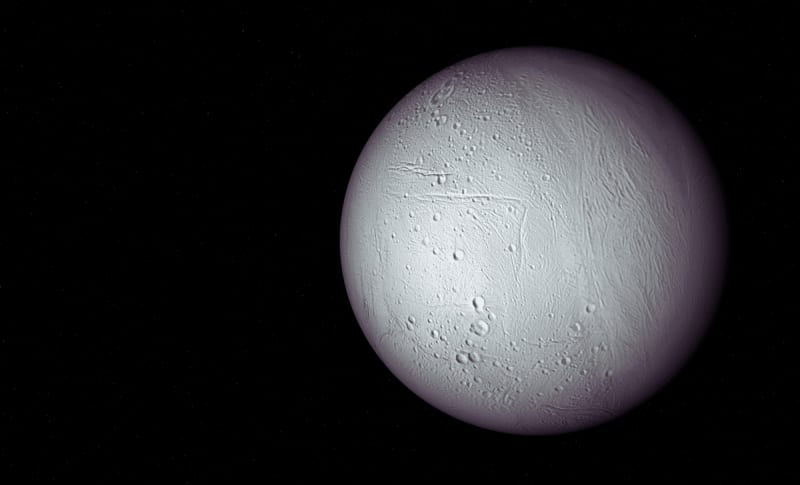
Image credit: Canva | The Daily Galaxy –Great Discoveries Channel
**Saturn’s icy moon Enceladus **has long fascinated scientists, with its active geysers and hidden ocean beneath a thick icy shell. Now, a groundbreaking study has revealed new clues that may bring us closer to understanding whether Enceladus could harbor life. By uncovering heat leaking from both poles of the moon, researchers have reinforced the idea that this distant world might have the energy required to sustain life. Published in Science Advances, this study offers a fresh perspective on the long-term viability of its subsurface ocean.
Hidden Heat Flow at Both Poles: A Game-Changer
For decade…

Image credit: Canva | The Daily Galaxy –Great Discoveries Channel
**Saturn’s icy moon Enceladus **has long fascinated scientists, with its active geysers and hidden ocean beneath a thick icy shell. Now, a groundbreaking study has revealed new clues that may bring us closer to understanding whether Enceladus could harbor life. By uncovering heat leaking from both poles of the moon, researchers have reinforced the idea that this distant world might have the energy required to sustain life. Published in Science Advances, this study offers a fresh perspective on the long-term viability of its subsurface ocean.
Hidden Heat Flow at Both Poles: A Game-Changer
For decades, scientists believed that only Enceladus’ south pole was releasing heat due to its active geysers. However, a recent study challenges that view by showing that the moon is leaking heat from both its poles. The new findings, based on data collected by NASA’s Cassini spacecraft, suggest that Enceladus is far more thermally active than previously thought. The discovery of heat at the north pole of Enceladus is crucial because it indicates that the moon’s internal energy is distributed across the entire surface, not just concentrated in one area.
As Dr. Georgina Miles, the lead author of the study, explains,
“Enceladus is a key target in the search for life outside the Earth, and understanding the long-term availability of its energy is key to determining whether it can support life.”
This discovery helps to reinforce the idea that Enceladus may be more than just an icy, frozen world. The heat detected at both poles could mean that Enceladus has the energy required to maintain**liquid water **in its subsurface ocean for an extended period—potentially billions of years. This thermal activity supports the notion that conditions on the moon may be favorable for life to evolve, particularly in the liquid ocean that lies beneath the icy shell.

Image
The Crucial Role of Energy in Supporting Life
The key to understanding whether life could thrive on **Enceladus **lies in the stability of its energy flow. Life as we know it requires a constant source of energy, and Enceladus’ ocean must maintain a delicate balance between heat gained and lost to remain liquid. Tidal heating, a process driven by Saturn’s immense gravitational pull on the moon, is believed to be the primary mechanism keeping the ocean warm. When Saturn’s gravity flexes Enceladus during its orbit, internal friction generates heat, allowing the ocean to remain stable.
The study published in Science Advances reveals that** Enceladus’ global heat loss** is in line with predictions based on tidal heating, offering new evidence that the moon’s internal heat is sufficient to sustain its ocean over geological timescales.
“Understanding how much heat Enceladus is losing on a global level is crucial to knowing whether it can support life,” said Dr. Carly Howett, the corresponding author of the paper.
The results point to a stable energy flow, indicating that Enceladus’ ocean is not only warm enough to support life but could remain so for a significant amount of time.
Tidal Heating and Its Impact on Enceladus’ Ocean
The process of tidal heating plays a critical role in keeping Enceladus’ ocean from freezing. When**Saturn’s gravitational forces **stretch and squeeze the moon as it orbits, this generates friction within the moon’s icy shell, causing it to heat up. This friction, or “tidal flexing,” is thought to be the source of the heat that keeps the subsurface ocean in a liquid state, despite the frigid temperatures of space.
What’s particularly intriguing about the new findings is how they align with the existing models of tidal heating. The thermal measurements gathered by Cassini suggest that the heat Enceladus emits from both poles is consistent with predictions of how much tidal energy is being converted into heat. This finding offers strong evidence that the moon’s internal heating system is both efficient and sustainable. Scientists now believe that this process could allow **Enceladus’ ocean **to remain stable for millions, or even billions, of years—long enough to potentially support life.
Insights into the Thickness of Enceladus’ Icy Shell
One of the most exciting aspects of the study is the new estimate of Enceladus’ icy shell thickness, which is a crucial factor for future missions aiming to explore its ocean. Based on temperature data from**Cassini, researchers **have determined that the ice is about 20 to 23 kilometers thick at the north pole and slightly thicker—around 25 to 28 kilometers—on average across the moon. These findings provide valuable data for any future spacecraft planning to drill or dive into Enceladus’ ocean.
While the icy shell is thick, it’s not impenetrable. The thermal measurements suggest that enough heat is leaking through to potentially allow a mission to access the subsurface ocean.
“Eking out the subtle surface temperature variations caused by Enceladus’ conductive heat flow from its daily and seasonal temperature changes was a challenge, and was only made possible by Cassini’s extended missions,” Dr. Miles adds.
This study not only increases our understanding of the moon’s internal heat flow but also lays the groundwork for future exploration of its ocean world.
Enjoyed this article? Subscribe to our free newsletter for engaging stories, exclusive content, and the latest news.